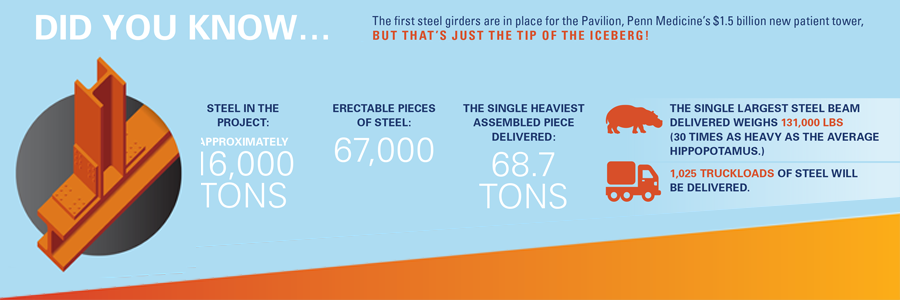Last May, Penn Medicine officially broke ground on its new, $1.5 billion hospital, known as the Pavilion. It is the largest capital building project in Penn’s history and Philadelphia’s most sophisticated and ambitious health care building. But before we look forward to all the building will have to offer when it’s complete in 2021, let’s take a look back at the progress that has been made during these past 12 months to ensure that the Pavilion will be the model of the future of health care.
Laying a Solid Foundation
Shortly after breaking ground, crews began working to make sure the foundation was solid. For more than 14 hours, 654 trucks poured more than 6,500 cubic yards of concrete into the Pavilion’s foundation -- enough to fill a Goodyear Blimp! The pour, which took place in July 2017, was the largest single concrete pour in Philadelphia’s history.
More than 16,000 tons of steel have also been put in place, including one of the largest steel beams on the east coast, weighing more than 131,000 pounds.

A Collaborative Process Three Years in the Making
But just as important as the structure of the building is the structure of team that has been planning it for more than three years. Occupying a full-floor of a co-location space in University City, the PennFIRST team has been working together since early 2015 to ensure that the Pavilion will offer the very best in health care for patients and employees.
Penn Medicine staff, including two full-time clinical liaisons, share office space with non-clinical staff such as designers, project managers, and architects, while mock-ups of patient rooms continue to be adjusted just down the hall. PennFIRST has taken the process of building a cutting-edge hospital as an opportunity to discover along the way how one should be designed.
In 2015-2016, PennFIRST oversaw the construction of a 30,000 square-foot full-scale foam mockup – equivalent to half a patient floor) in a warehouse. More than 600 Penn staff members practiced simulation scenarios in the space and provided feedback for how the space could better function. Members of the Patient Advisory Board were also invited to tour the mock-up to provide their insights. The result? A total redesign of the space that is now reflected in the building’s design. But the team isn’t done yet, and the final touches are still very much a work in progress as PennFIRST continues to run focus groups to nail down more design specifics, such as room adjacencies and in-room outlets. There are full-scale foam mockups of a patient room and an operating room at the team’s co-location space; these continue to serve as a venue for additional testing. The team will later add selected furniture and design finishes.
“Having the feedback from so many different perspectives really started to shine the light on the operational changes necessary,” said Kate Newcomb-DeSanto, MSN, RN, MSW, a clinical liaison for PennFIRST.
The team is also focused on the patient and visitor experience. Using a demographic database of Penn Medicine patients, a PennFIRST team created several unique “personas,” fictional patients who would visit the Pavilion.
In large “human experience” workshops, multidisciplinary teams from Penn Medicine including clinicians, support services, and patient advocates mapped experiences through the eyes of each persona to help the design team better understand how a patient might feel during each touch point. Understanding the human experience allows the designers to customize the architecture to optimize the experience and journey, creating operations and systems of the facility to be more personal, efficient, and easy to navigate.
Focus on Employee Health
When complete, the Pavilion will be a state-of-the-art facility offering some of the best health care in the world, Penn’s commitment to providing quality care starts with those who are working to build this facility.
To raise awareness about high blood pressure – which the American Heart Association says affects one out of every three adults over age 20 – in August PennFIRST began a partnership with the Penn Medicine Center for Healthcare Innovation to offer free on-site blood pressure screenings for construction crews at the Pavilion. Most of the time there are no obvious symptoms and, if left untreated, high blood pressure can damage the circulatory system, and contribute to heart attack, stroke, and other health issues.
Just last week, PennFIRST partnered with representatives from the Occupational Safety and Health Administration (OSHA) and building construction managers LF Driscoll and Balfour Beatty to participate in the National Safety Stand Down, an event that provides an opportunity for employers to talk directly to employees about safety. Fatalities caused by falls from elevation continue to be a leading cause of death for construction employees, accounting for 370 of the 991 construction fatalities recorded in 2016. The National Safety Stand-Down raises fall hazard awareness and reviews important safety standards in an effort to stop fall fatalities and injuries.
“Penn Medicine encourages preventative screenings and safety measures for all employees, and as a vital part of building our future, the PennFIRST construction team is no different,” Newcomb-DeSanto said.
With just about three years to go before the Pavilion doors open, Penn Medicine’s approach to technology, collaboration, safety and quality of care for patients, employees, and construction teams shows no signs of easing up. In fact, the PennFIRST team has plans to evaluate and incorporate technologies and pathways that have yet to be invented—an ongoing process that will certainly keep the health system on the forefront.